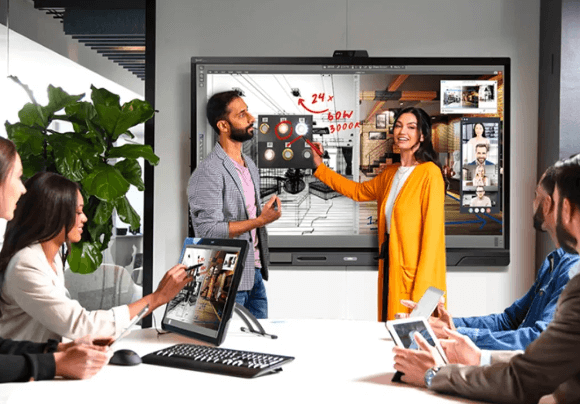Why Interactive Flat Panels Are the Ideal Solution for Hybrid Learning Models

Hybrid learning models, which combine in-person and remote instruction, have become an essential part of modern education. This flexible approach allows students to learn from anywhere, accommodating diverse needs and circumstances. However, the shift to hybrid learning presents new challenges for educators, such as maintaining student engagement, ensuring seamless interaction, and delivering high-quality lessons to both in-person and remote learners. Interactive flat panels (IFPs) are proving to be the perfect solution for these challenges, offering a versatile, interactive platform that bridges the gap between the physical classroom and the digital world.
The Challenges of Hybrid Learning
Hybrid learning aims to provide the best of both worlds, combining the structure and social benefits of in-person learning with the flexibility and accessibility of remote education. However, it also brings challenges that can impact the learning experience if not addressed properly. Teachers must engage two groups of students simultaneously—those in the classroom and those at home—without compromising the quality of instruction. Traditional tools like whiteboards and projectors fall short in hybrid settings, often leaving remote students feeling disconnected.
To create an effective hybrid learning environment, educators need tools that enable interaction, engagement, and collaboration for all students, regardless of location. This is where interactive flat panels come into play, providing a dynamic and versatile solution that enhances the hybrid learning experience.
See also: The Rise of Eco-Friendly Homes: A Step Towards Sustainable Living
How Interactive Flat Panels Support Hybrid Learning Models
Interactive flat panels for classrooms are large, touch-enabled displays that combine the capabilities of a digital whiteboard, computer, and multimedia center into one powerful tool. They are designed to facilitate interactive learning and are equipped with features that make them ideal for hybrid education. Here’s why interactive flat panels are the perfect solution for hybrid learning models:
1. Seamless Integration of In-Person and Remote Learning
Interactive flat panels make it easy for teachers to deliver lessons that engage both in-person and remote students simultaneously. The panels can connect directly to video conferencing platforms like Zoom, Microsoft Teams, or Google Meet, allowing remote students to see everything that’s happening in the classroom. Teachers can share the panel’s screen with remote students, ensuring they have the same view as those physically present.
For example, during a math lesson, a teacher can solve equations on the interactive panel while students at home watch the process in real-time. Both groups can interact with the lesson by asking questions, responding to prompts, or even solving problems directly on the screen if given control access. This seamless integration ensures that all students are part of the learning experience, no matter where they are.
2. Enhanced Student Engagement Through Interactivity
One of the biggest challenges in hybrid learning is keeping remote students engaged. Interactive flat panel address this by turning lessons into interactive experiences that capture students’ attention. Teachers can use the panel’s touch capabilities to create interactive lessons that involve students directly, such as dragging and dropping elements, annotating on the screen, or participating in virtual simulations.
For instance, in a science class, students can conduct virtual lab experiments on the panel, manipulating variables and observing outcomes. Remote students can follow along, participate, and even control the experiment from their devices, making them active participants rather than passive observers. This level of interactivity helps maintain student engagement, making hybrid lessons feel more connected and engaging for everyone involved.
3. Facilitating Collaborative Learning Across Locations
Hybrid learning often lacks the collaborative element that is crucial for developing communication and teamwork skills. Interactive flat panels help bridge this gap by enabling real-time collaboration between in-person and remote students. Using cloud-based whiteboard apps and interactive tools, students can work on projects, brainstorm ideas, and share their work on the panel, regardless of their location.
For example, during a group project, students in the classroom can use the panel to display their work, while remote students can contribute their input through shared documents or collaborative apps displayed on the screen. This collaborative approach ensures that all students, whether in the classroom or at home, can work together seamlessly, fostering a sense of community and teamwork.
4. Access to a Wealth of Digital Resources
Interactive flat panel bring the power of the internet into the classroom, providing instant access to a vast array of digital resources that enhance hybrid learning. Teachers can pull up videos, online articles, simulations, and other multimedia content directly on the panel, enriching the learning experience for both in-person and remote students.
For instance, in a history lesson, teachers can use the panel to take students on a virtual tour of historical sites, stream documentaries, or display primary source documents for analysis. Remote students can see everything the in-class students see, and everyone can participate in discussions and activities. This access to diverse resources makes lessons more engaging and informative, catering to various learning styles and keeping all students involved.
5. Streamlined Lesson Delivery and Management
Interactive flat panels simplify the logistics of delivering lessons in a hybrid model. Teachers can easily switch between different teaching modes, such as presenting slides, displaying videos, conducting quizzes, or annotating on the screen. This flexibility allows educators to keep the lesson flowing smoothly without the need for multiple devices or complicated setups.
Additionally, interactive flat panels often come with built-in tools that allow teachers to record lessons and save annotations. This feature is particularly beneficial for hybrid learning, as recorded lessons can be shared with students who miss class or need to review the material. This accessibility ensures that all students have the resources they need to succeed, even if they cannot attend live sessions.
Real-World Applications: Interactive Panels in Hybrid Classrooms
Schools worldwide are adopting interactive flat panels to enhance their hybrid learning environments, with impressive results. For example, a school in California integrated interactive panels into their hybrid classrooms, enabling teachers to conduct engaging lessons that seamlessly included both in-person and remote students. Teachers reported that the panels helped keep students connected and engaged, improving participation and overall learning outcomes.
In another case, a high school in Texas used interactive flat panels to facilitate group work in a hybrid setting. Students collaborated on projects using the panels’ shared whiteboard feature, allowing everyone to contribute regardless of their location. This approach not only enhanced learning but also helped build a strong sense of community among students who were physically separated.
Conclusion: The Future of Hybrid Learning with Interactive Flat Panels
Interactive flat panels are revolutionizing the hybrid learning model by providing a versatile, interactive platform that connects in-person and remote students like never before. With their ability to integrate seamlessly with digital resources, facilitate real-time collaboration, and enhance student engagement, interactive flat panels are the ideal solution for today’s hybrid classrooms.
For schools and educators looking to navigate the complexities of hybrid learning, investing in interactive flat panels is a strategic move that ensures high-quality education for all students, no matter where they are. As the education landscape continues to evolve, interactive flat panels will play a crucial role in shaping the future of learning, making it more inclusive, engaging, and effective for every student.




